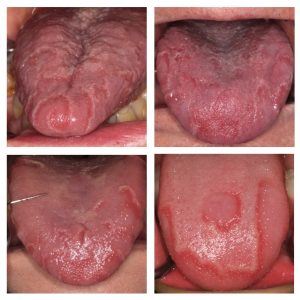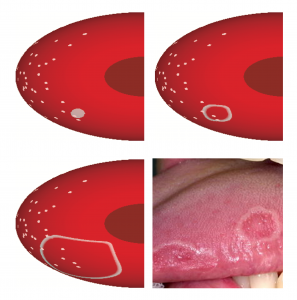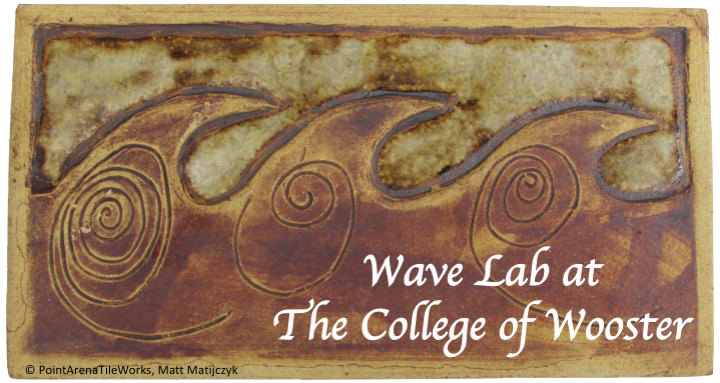 Geographic tongue (GT) is a condition of unknown cause characterized by chronic inflammatory lesions migrating over the surface of the tongue. The lesions have a leading edge of white and sometimes a visible lagging edge of red, bordered on both sides by normal tongue mucosa. GT can manifest with linear wavefronts, circular wavefronts, and even spirals. The surface of the tongue is covered by a specialized epithelial mucosa that consists of four types of heterogeneously distributed papilla. One of those types, the filiform papilla, which predominate over the front two thirds of the tongue and do not contain taste buds, are responsible for GT.
Geographic tongue (GT) is a condition of unknown cause characterized by chronic inflammatory lesions migrating over the surface of the tongue. The lesions have a leading edge of white and sometimes a visible lagging edge of red, bordered on both sides by normal tongue mucosa. GT can manifest with linear wavefronts, circular wavefronts, and even spirals. The surface of the tongue is covered by a specialized epithelial mucosa that consists of four types of heterogeneously distributed papilla. One of those types, the filiform papilla, which predominate over the front two thirds of the tongue and do not contain taste buds, are responsible for GT.
Geographic tongue has acquired many names since its first description by Rayer in 1831. These names include benign migratory glossitis, erythema migrans lingualis, psoriasiform mucositis, and wandering rash of the tongue, among many others. Geographic tongue became popular because of its map-like appearance. Unfortunately, the term geographic tongue suggests the patterning of the tongue is static, which is misleading. The term migratory glossitis is the most technically correct; a glossitis refers to a desquamation of the papilla on the tongue, and migratory glossitis emphasizes the mobility of the condition across the surface of the tongue.
 Margaret McGuire ’20, a pre-dental Math major, started modeling GT during our 2018 summer research program with the help of Dr. Lindner in Objective-C. A two-variable reaction-diffusion (RD) system had been used to simulate the behavior of RD waves on the curved tongue surface which is approximated by an ellipsoid. The program included anisotropic diffusion which we did not use in our simulations. It had been added because it was the necessary condition to create elongated GT patterns in an article from 2015 (G. Seiden and S. Curland, The tongue as an excitable medium, New Journal of Physics 17(3) (2015) 03304). Margaret found that the curvature effects by the surface on the wave propagation are sufficient to create non-circular wave fronts. In combination with Chase Fuller’s visualizations, we obtained a pretty solid understanding of the wave’s behavior.
Margaret McGuire ’20, a pre-dental Math major, started modeling GT during our 2018 summer research program with the help of Dr. Lindner in Objective-C. A two-variable reaction-diffusion (RD) system had been used to simulate the behavior of RD waves on the curved tongue surface which is approximated by an ellipsoid. The program included anisotropic diffusion which we did not use in our simulations. It had been added because it was the necessary condition to create elongated GT patterns in an article from 2015 (G. Seiden and S. Curland, The tongue as an excitable medium, New Journal of Physics 17(3) (2015) 03304). Margaret found that the curvature effects by the surface on the wave propagation are sufficient to create non-circular wave fronts. In combination with Chase Fuller’s visualizations, we obtained a pretty solid understanding of the wave’s behavior.
Senior Independent Study theses
- Margaret McGuire ’20 (2020) : What a Mouthful! Geographic Tongue as a Reaction-Diffusion System
Summer research experience
- Margaret McGuire (2019, Sherman Fairchild grant) : Reaction-Diffusion Models of 2D surfaces embedded in 3D Space and a Model of Geographic Tongue
Oral presentations
- Margaret McGuire: “Reaction-diffusion models of 2D surfaces embedded in 3D space and a model of geographic tongue”, 47th Annual Mathematics Conference: Differential Equations and Dynamical Systems and their Applications, Miami University, Oxford, OH, 2019 September 20-21
Poster presentations
- M. K. McGuire, C. A. Fuller, J. F. Lindner, and N. Manz: “Geographic Tongue as a Reaction-Diffusion System”, Spring 2021 Meeting of the APS Ohio-Region Section, virtual, 2021 April 9
- M. K. McGuire, C. A. Fuller, J. F. Lindner, and N. Manz: “Geographic Tongue as a Reaction-Diffusion System”, 37th Annual Research Day, University of North Carolina at Chapel Hill Adams School of Dentistry, 2021 March 17
Publications (click for more info)
- M. K. McGuire, C. A. Fuller, J. F. Lindner, and N. Manz, Geographic Tongue as a Reaction-Diffusion System, Chaos: An Interdisciplinary Journal of Nonlinear Science 3 (2021), 033118 (DOI)
- Wooster Weekly News: Shout-Out to Interdisciplinary Team Investigating Geographic Tongue
- Wooster Physics Blog: Geographic Tongue
- N. Manz and F. H. Fenton, Patterns and Humans in ‘Spirals and Vortices‘ (Kinko Tsuji and Stefan C. Müller, Eds.) Springer International Publishing (2019), 217-224.
